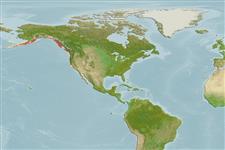>
Perciformes/Cottoidei (Sculpins) >
Cottidae (Sculpins)
Etymology: Enophrys: Greek, enophrys = with enlarged, inflated eye brow (Ref. 45335); bison: Named after the North American buffalo (Ref. 6885).
More on author: Girard.
Environment: milieu / climate zone / depth range / distribution range
Ökologie
seewasser demersal; tiefenbereich ? - 20 m (Ref. 2850). Temperate; 65°N - 34°N, 165°W - 119°W
Eastern Pacific: Kodiak Island, Alaska to Monterey Bay, California, USA.
Size / Gewicht / Alter
Maturity: Lm ? range ? - ? cm
Max length : 37.0 cm TL Männchen/unbestimmt; (Ref. 2850)
Rückenflossenstacheln (insgesamt) : 7 - 9; Rückenflossenweichstrahlen (insgesamt) : 10 - 13; Afterflossenstacheln: 0; Afterflossenweichstrahlen: 8 - 9. Caudal broadly rounded. Pelvic fins small.
Commonly found in inshore rocky and sandy areas (Ref. 2850). Feeds mainly on algae (Ref. 2850) but also shrimps, crabs, amphipods, mussels, and small fishes (Ref. 4925).
Oviparous (Ref. 101741). Male guards egg cluster and fans eggs with his pectoral fins (Ref. 2850).
Eschmeyer, W.N., E.S. Herald and H. Hammann, 1983. A field guide to Pacific coast fishes of North America. Boston (MA, USA): Houghton Mifflin Company. xii+336 p. (Ref. 2850)
IUCN Rote Liste Status (Ref. 130435: Version 2024-2)
Bedrohung für Menschen
Harmless
Nutzung durch Menschen
Fischereien: kommerziell; Sportfisch: ja; Aquarium: Öffentliche Aquarien
Tools
Zusatzinformationen
Download XML
Internet Quellen
Estimates based on models
Preferred temperature (Ref.
123201): 6.4 - 12.1, mean 8.9 °C (based on 280 cells).
Phylogenetic diversity index (Ref.
82804): PD
50 = 0.5625 [Uniqueness, from 0.5 = low to 2.0 = high].
Bayesian length-weight: a=0.00794 (0.00386 - 0.01635), b=3.12 (2.95 - 3.29), in cm total length, based on LWR estimates for this (Sub)family-body shape (Ref.
93245).
Trophic level (Ref.
69278): 3.3 ±0.52 se; based on food items.
Widerstandsfähigkeit (Ref.
120179): sehr niedrig, Verdopplung der Population dauert mehr als 14 Jahre. (Preliminary K or Fecundity.).
Fishing Vulnerability (Ref.
59153): Low to moderate vulnerability (27 of 100).
